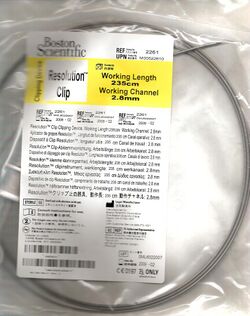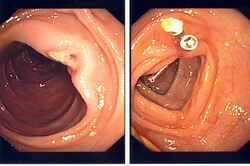Medicine:Endoclip
An endoclip is a metallic mechanical device used in endoscopy in order to close two mucosal surfaces without the need for surgery and suturing. Its function is similar to a suture in gross surgical applications, as it is used to join together two disjointed surfaces, but, can be applied through the channel of an endoscope under direct visualization. Endoclips have found use in treating gastrointestinal bleeding (both in the upper and lower GI tract), in preventing bleeding after therapeutic procedures such as polypectomy, and in closing gastrointestinal perforations. Many forms of endoclips exist of different shapes and sizes, including two and three prong devices, which can be administered using single use and reloadable systems, and may or may not open and close to facilitate placement.
Structure and function
The endoclip was first described by Hayashi and Kudoh in 1975,[1] and was termed the "staunch clip". Initial attempts to incorporate the clip into applications in endoscopy (such as clipping bleeding blood vessels) were limited by the applicator system of the clip.[1] However, by 1988, an easy to use applicator delivery system was developed, and a functional reloadable endoclip system was described.[2] This consisted of a stainless steel clip (of size approximately 6 mm long and 1.2 mm wide at the prongs) with a metal deployment device (that could be used to insert the clip into the endoscopic camera, and deployed outside the camera) enclosed in a plastic sheath.[1] These clips were initially reloadable.[citation needed]
Endoclips in use today have a variety of additional shapes and sizes than the original. Clips with two and three prongs (TriClip, Cook Medical[3]) have been described and used for various applications.[4] Rotatable clips have been devised to improve localization of deployment.[5] Also, clips that open and close (as opposed to single-deployment) have also been developed (Resolution Clip, Boston Scientific[6]), and also facilitate the appropriate location of deployment.[7]
When a treatable lesion is identified on endoscopy (such as a bleeding vessel), an endoclip can be inserted through the channel of the endoscope until the sheathed clip is visible on the endoscopic image, and the handle for deployment handed to the nurse assistant. The clip is unsheathed by retraction at the handle, positioned, and "fired" by the assistant to treat the lesion.[citation needed]
Applications of endoclips
Gastrointestinal bleeding
Endoclips have found a primary application in hemostasis (or the stopping of bleeding) during endoscopy of the upper (through gastroscopy) or lower (through colonoscopy) gastrointestinal tract.[1] Many bleeding lesions have been successfully clipped, including bleeding peptic ulcers,[4] Mallory-Weiss tears of the esophagus,[8] Dieulafoy's lesions,[9] stomach tumours,[10] and bleeding after removal of polyps.[11] Bleeding peptic ulcers require endoscopic treatment if they show evidence of high risk stigmata of re-bleeding, such as evidence of active bleeding or oozing on endoscopy or the presence of a visible blood vessel around the ulcer.[12][13] The alternatives to endoscopic clipping of peptic ulcers are thermal therapy (such as electrocautery to burn the vessel causing the bleeding), or injection of epinephrine to constrict the blood vessel. Comparative studies between endoclips and thermal therapy make the point that endoclips cause less trauma to the mucosa around the ulcer than electrocautery,[14] but no definitive advantage to either approach has reached consensus by gastroenterologists.[15][16]
Other applications
Endoclips have also found an application in preventing bleeding when performing complicated endoscopic procedures. For example, prophylactic clipping of the base of a polyp has been found to be useful in preventing post-polypectomy bleeding, especially in high-risk patients or patients on anticoagulant medications.[17] In addition, clips can be used to close gastrointestinal perforations that may have been caused by complicated therapeutic endoscopy procedures, such as polypectomy, or by the endoscopic procedure itself.[18] Clips have also been used to secure the placement of endoscopic feeding tubes,[19] and to orient the bile duct to assist with endoscopic retrograde cholangiopancreatography, a procedure used to image to bile duct.[20]
Safety
Endoclips have been seen to dislodge between 1 and 3 weeks from deployment,[21] although lengthy clip retention intervals of as high as 26 months have been reported.[1][9] Endoclips are believed to be safe and no major complications (such as perforation or impaction) have been reported with them, although concern has been raised about blocking the outflow of the bile duct if clips are deployed in the duodenum.[1]
References
- ↑ 1.0 1.1 1.2 1.3 1.4 1.5 "Endoclip: closing the surgical gap". Gastrointest. Endosc. 50 (3): 440–2. 1999. doi:10.1053/ge.1999.v50.99616. PMID 10462677.
- ↑ "Endoscopic hemoclip treatment for gastrointestinal bleeding". Endoscopy 25 (2): 167–70. 1993. doi:10.1055/s-2007-1010277. PMID 8491134.
- ↑ "TriClip Endoscopic Clipping Device". http://www.cookmedical.com/esc/dataSheet.do?id=700.
- ↑ 4.0 4.1 "Endoscopic hemoclip versus triclip placement in patients with high-risk peptic ulcer bleeding". Am. J. Gastroenterol. 102 (3): 539–43. 2007. doi:10.1111/j.1572-0241.2006.00962.x. PMID 17100962.
- ↑ "Feasibility study on endoscopic suture with the combination of a distal attachment and a rotatable clip for complications of endoscopic resection in the large intestine". Endoscopy 32 (6): 477–80. 2000. doi:10.1055/s-2000-648. PMID 10863916.
- ↑ "Resolution Clip". http://www.bostonscientific.com/med_specialty/deviceDetail.jsp?task=tskBasicDevice.jsp§ionId=4&relId=7,334,335,336&deviceId=16057&uniqueId=MPDB4329.
- ↑ "Randomized controlled study of 3 different types of hemoclips for hemostasis of bleeding canine acute gastric ulcers". Gastrointest. Endosc. 64 (5): 768–73. 2006. doi:10.1016/j.gie.2006.06.031. PMID 17055872.
- ↑ "Endoscopic hemoclipping for upper GI bleeding due to Mallory-Weiss syndrome". Gastrointest. Endosc. 53 (4): 427–30. 2001. doi:10.1067/mge.2001.111774. PMID 11275881.
- ↑ 9.0 9.1 "Dieulafoy's disease treated by endoscopic haemostatic clipping". J. Gastroenterol. Hepatol. 13 (3): 320–1. 1998. doi:10.1111/j.1440-1746.1998.01547.x. PMID 9570248.
- ↑ "Endoscopic hemostasis for bleeding gastric stromal tumors by application of hemoclip". Journal of Laparoendoscopic & Advanced Surgical Techniques. Part A 14 (3): 169–71. 2004. doi:10.1089/1092642041255522. PMID 15245670.
- ↑ "[Post-polypectomy colonic arterial hemorrhage can be treated by hemoclipping]" (in fr). Gastroenterol. Clin. Biol. 25 (3): 323–4. 2001. PMID 11395682.
- ↑ "The effect of endoscopic therapy in patients receiving omeprazole for bleeding ulcers with nonbleeding visible vessels or adherent clots: a randomized comparison". Ann. Intern. Med. 139 (4): 237–43. 2003. doi:10.7326/0003-4819-139-4-200308190-00005. PMID 12965978.
- ↑ "Effect of intravenous omeprazole on recurrent bleeding after endoscopic treatment of bleeding peptic ulcers". N. Engl. J. Med. 343 (5): 310–6. 2000. doi:10.1056/NEJM200008033430501. PMID 10922420.
- ↑ "Endoclips versus heater probe in preventing early recurrent bleeding from peptic ulcer: a prospective and randomized trial". Gastrointest. Endosc. 53 (2): 147–51. 2001. doi:10.1067/mge.2001.111386. PMID 11174282.
- ↑ "A prospective, randomized trial of endoscopic hemoclip versus heater probe thermocoagulation for peptic ulcer bleeding". Am. J. Gastroenterol. 97 (9): 2250–4. 2002. doi:10.1111/j.1572-0241.2002.05978.x. PMID 12358241.
- ↑ "Endoscopic treatment of ulcer bleeding". Current Treatment Options in Gastroenterology 10 (2): 143–8. 2007. doi:10.1007/s11938-007-0066-3. PMID 17391629.
- ↑ "Colonoscopy with polypectomy in anticoagulated patients". Gastrointest. Endosc. 64 (1): 98–100. 2006. doi:10.1016/j.gie.2006.02.030. PMID 16813811.
- ↑ "Endoscopic clip application for closure of esophageal perforations caused by EMR". Gastrointest. Endosc. 60 (4): 636–9. 2004. doi:10.1016/S0016-5107(04)01960-1. PMID 15472698.
- ↑ "Endoscopic placement of jejunal feeding tubes by using the Resolution clip: report of 2 cases". Gastrointest. Endosc. 64 (3): 454–6. 2006. doi:10.1016/j.gie.2006.02.051. PMID 16923504. https://zenodo.org/record/1258999.
- ↑ "Endoscopic clip-assisted biliary cannulation: externalization and fixation of the major papilla from within a duodenal diverticulum using the endoscopic clip fixing device". Gastrointest. Endosc. 50 (3): 431–6. 1999. doi:10.1053/ge.1999.v50.97369. PMID 10462673.
- ↑ "Endoscopic closure of a perforation using metallic clips after snare excision of a gastric leiomyoma". Gastrointest. Endosc. 39 (2): 172–4. 1993. doi:10.1016/S0016-5107(93)70060-7. PMID 8495838.
 |





